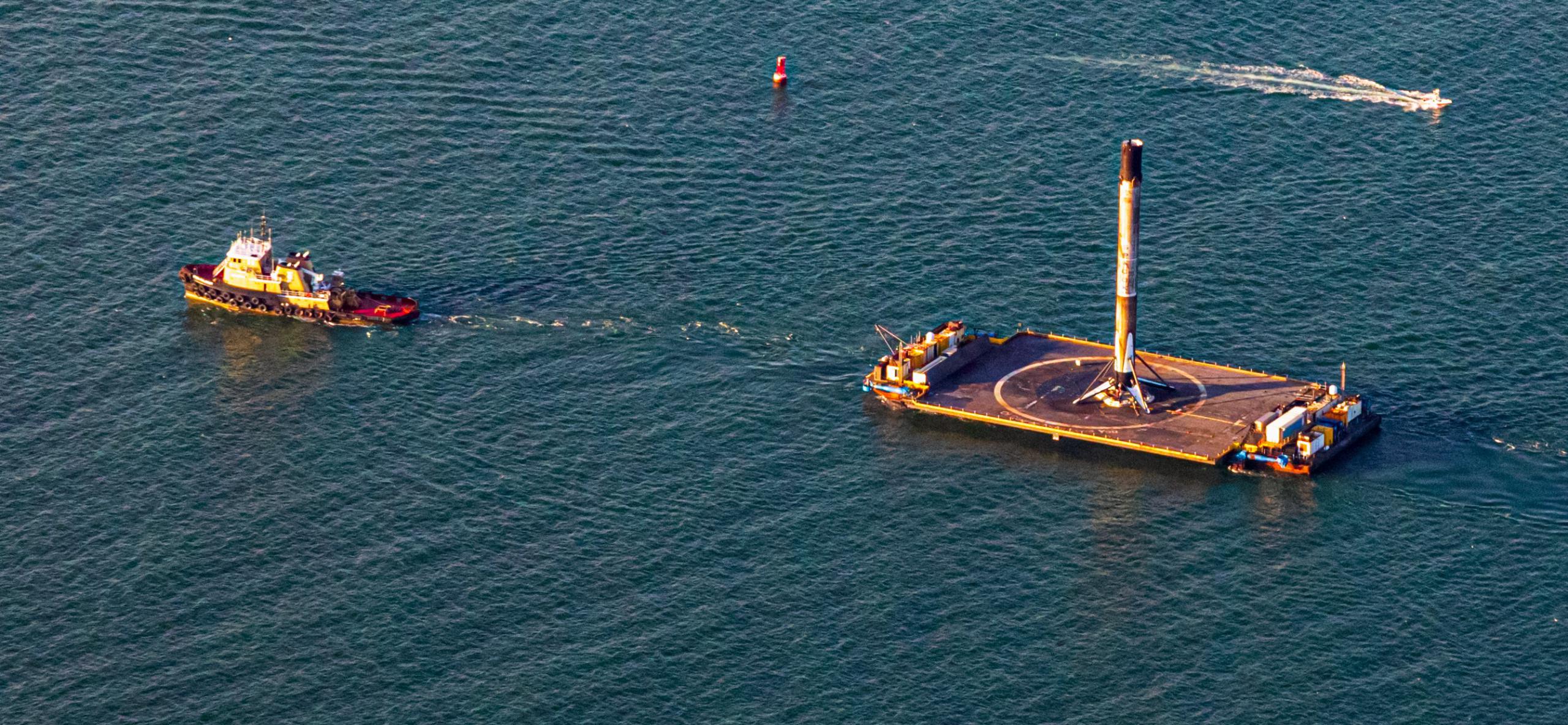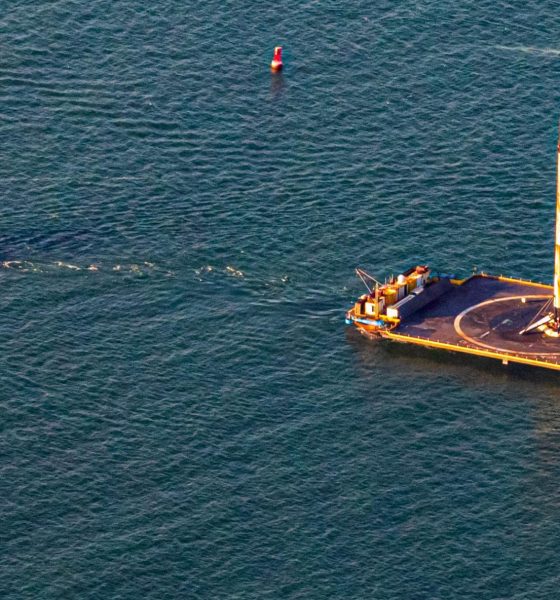

News
SpaceX’s next West Coast Starlink launch likely delayed as drone ship returns to port
Update: Less than a day after departing Port of Long Beach, California, SpaceX drone ship Of Course I Still Love You (OCISLY) has turned around and appears to be on its way back, signaling a last-minute delay for the company’s second West Coast Starlink launch.
Normally, SpaceX doesn’t halt drone ship trips downrange for just a day or two of launch delays, suggesting that Starlink 2-3 could slip at least several days beyond its current October 17th and 18th target and backup dates.
A pair of notices to mariners (NTMs) published earlier this week reveal that SpaceX could conduct its second West Coast Starlink launch as early as Sunday, October 17th.
Used to delineate certain regions mariners should temporarily avoid or heed caution in, NTMs – while cryptic – often reveal roughly when a rocket launch or spacecraft reentry is expected to occur days or weeks before NASA, the US military, or any companies involved announce an official target. That now appears to be the case for SpaceX’s “Starlink Group 2-3” mission, which is set to be the second dedicated launch of polar Starlink satellites. Presumably identical to Starlink 2-1, which successfully launched on a Falcon 9 rocket on September 14th, Starlink 2-3 will likely carry another 51 upgraded Starlink V1.5 satellites.
Each fitted with several custom SpaceX-built lasers known as optical interlinks or OILs, Starlink Group 2 satellites will (roughly) orbit Earth’s poles instead of its equator and will eventually use those lasers to allow the rest of the Starlink constellation to route user communications entirely in space. Whereas current Starlink internet users must live within a few hundred miles of a SpaceX ground station to access the network, a constellation of satellites with laser interlinks could serve anyone on Earth – practically independent of ground station location – by routing user communications through any number of laser-linked satellites.
Once all ~1600 Starlink V1.0 satellites are replaced with V1.5 spacecraft, SpaceX will have effectively created a second internet independent of the millions of miles of copper and fiber optic cables that nearly all modern users rely on. Of course, SpaceX’s Starlink V1.5 and V2.0+ constellation will mainly function as an extension of that existing network, but it will allow unprecedented feats of routing – latency that no wired network can physically match, in other words.
The primary draw for a laser-linked constellation, though, is the ability to connect users to the internet almost regardless of location. On top of hundreds of millions of rural and underserved or unserved customers worldwide, even including those trapped inside restrictive national ‘firewalls,’ an interlinked constellation will allow SpaceX to deliver unprecedentedly high-quality connectivity to ships, planes, trains, and road vehicles. Currently only served by mediocre and marginally reliable geostationary providers at great cost, disrupting those captive markets with a service as many leagues above as Starlink could singlehandedly secure SpaceX billions of dollars of annual revenue.
Soon after the notices to mariners appeared, Next Spacefight’s Michael Baylor confirmed that the Starlink 2-3 mission is scheduled to launch out of Vandenberg Air/Space Force Base no earlier than (NET) 10:34 am PDT (UTC-7) on Sunday, October 17th. The launch window is open for one hour and, like Starlink 2-1, will likely involve a Falcon 9 booster landing attempt a few hundred miles downrange on drone ship Of Course I Still Love You (OCISLY).
It remains to be seen which Falcon booster is assigned to the launch or if SpaceX will static fire it several days before.

News
Tesla (TSLA) receives “Buy” rating and $551 PT from Canaccord Genuity
He also maintained a “Buy” rating for TSLA stock over the company’s improving long-term outlook, which is driven by autonomy and robotics.

Canaccord Genuity analyst George Gianarikas raised his Tesla (NASDAQ:TSLA) price target from $482 to $551. He also maintained a “Buy” rating for TSLA stock over the company’s improving long-term outlook, which is driven by autonomy and robotics.
The analyst’s updated note
Gianarikas lowered his 4Q25 delivery estimates but pointed to several positive factors in the Tesla story. He noted that EV adoption in emerging markets is gaining pace, and progress in FSD and the Robotaxi rollout in 2026 represent major upside drivers. Further progress in the Optimus program next year could also add more momentum for the electric vehicle maker.
“Overall, yes, 4Q25 delivery expectations are being revised lower. However, the reset in the US EV market is laying the groundwork for a more durable and attractive long-term demand environment.
“At the same time, EV penetration in emerging markets is accelerating, reinforcing Tesla’s potential multi‑year growth runway beyond the US. Global progress in FSD and the anticipated rollout of a larger robotaxi fleet in 2026 are increasingly important components of the Tesla equity story and could provide sentiment tailwinds,” the analyst wrote.
Tesla’s busy 2026
The upcoming year would be a busy one for Tesla, considering the company’s plans and targets. The autonomous two-seat Cybercab has been confirmed to start production sometime in Q2 2026, as per Elon Musk during the 2025 Annual Shareholder Meeting.
Apart from this, Tesla is also expected to unveil the next-generation Roadster on April 1, 2026. Tesla is also expected to start high-volume production of the Tesla Semi in Nevada next year.
Apart from vehicle launches, Tesla has expressed its intentions to significantly ramp the rollout of FSD to several regions worldwide, such as Europe. Plans are also underway to launch more Robotaxi networks in several more key areas across the United States.
News
Waymo sues Santa Monica over order to halt overnight charging sessions
In its complaint, Waymo argued that its self-driving cars’ operations do not constitute a public nuisance, and compliance with the city’s order would cause the company irreparable harm.

Waymo has filed a lawsuit against the City of Santa Monica in Los Angeles County Superior Court, seeking to block an order that requires the company to cease overnight charging at two facilities.
In its complaint, Waymo argued that its self-driving cars’ operations do not constitute a public nuisance, and compliance with the city’s order would cause the company irreparable harm.
Nuisance claims
As noted in a report from the Los Angeles Times, Waymo’s two charging sites at Euclid Street and Broadway have operated for about a year, supporting the company’s growing fleet with round-the-clock activity. Unfortunately, this has also resulted in residents in the area reportedly being unable to sleep due to incessant beeping from self-driving taxis that are moving in and out of the charging stations around the clock.
Frustrated residents have protested against the Waymos by blocking the vehicles’ paths, placing cones, and “stacking” cars to create backups. This has also resulted in multiple calls to the police.
Last month, the city issued an order to Waymo and its charging partner, Voltera, to cease overnight operations at the charging locations, stating that the self-driving vehicles’ activities at night were a public nuisance. A December 15 meeting yielded no agreement on mitigations like software rerouting. Waymo proposed changes, but the city reportedly insisted that nothing would satisfy the irate residents.
“We are disappointed that the City has chosen an adversarial path over a collaborative one. The City’s position has been to insist that no actions taken or proposed by Waymo would satisfy the complaining neighbors and therefore must be deemed insufficient,” a Waymo spokesperson stated.
Waymo pushes back
In its legal complaint, Waymo stated that its “activities at the Broadway Facilities do not constitute a public nuisance.” The company also noted that it “faces imminent and irreparable harm to its operations, employees, and customers” from the city’s order. The suit also stated that the city was fully aware that the Voltera charging sites would be operating around the clock to support Waymo’s self-driving taxis.
The company highlighted over one million trips in Santa Monica since launch, with more than 50,000 rides starting or ending there in November alone. Waymo also criticized the city for adopting a contentious strategy against businesses.
“The City of Santa Monica’s recent actions are inconsistent with its stated goal of attracting investment. At a time when the City faces a serious fiscal crisis, officials are choosing to obstruct properly permitted investment rather than fostering a ‘ready for business’ environment,” Waymo stated.
News
Tesla FSD v14.2.2 is getting rave reviews from drivers
So far, early testers have reported buttery-smooth drives with confident performance, even at night or on twisty roads.

Tesla Full Self-Driving (Supervised) v14.2.2 is receiving positive reviews from owners, with several drivers praising the build’s lack of hesitation during lane changes and its smoother decision-making, among others.
The update, which started rolling out on Monday, also adds features like dynamic arrival pin adjustment. So far, early testers have reported buttery-smooth drives with confident performance, even at night or on twisty roads.
Owners highlight major improvements
Longtime Tesla owner and FSD user @BLKMDL3 shared a detailed 10-hour impression of FSD v14.2.2, noting that the system exhibited “zero lane change hesitation” and “extremely refined” lane choices. He praised Mad Max mode’s performance, stellar parking in locations including ticket dispensers, and impressive canyon runs even in dark conditions.
Fellow FSD user Dan Burkland reported an hour of FSD v14.2.2’s nighttime driving with “zero hesitations” and “buttery smooth” confidence reminiscent of Robotaxi rides in areas such as Austin, Texas. Veteran FSD user Whole Mars Catalog also demonstrated voice navigation via Grok, while Tesla owner Devin Olsen completed a nearly two-hour drive with FSD v14.2.2 in heavy traffic and rain with strong performance.
Closer to unsupervised
FSD has been receiving rave reviews, even from Tesla’s competitors. Xpeng CEO He Xiaopeng, for one, offered fresh praise for FSD v14.2 after visiting Silicon Valley. Following extended test drives of Tesla vehicles running the latest FSD software, He stated that the system has made major strides, reinforcing his view that Tesla’s approach to autonomy is indeed the proper path towards autonomy.
According to He, Tesla’s FSD has evolved from a smooth Level 2 advanced driver assistance system into what he described as a “near-Level 4” experience in terms of capabilities. While acknowledging that areas of improvement are still present, the Xpeng CEO stated that FSD’s current iteration significantly surpasses last year’s capabilities. He also reiterated his belief that Tesla’s strategy of using the same autonomous software and hardware architecture across private vehicles and robotaxis is the right long-term approach, as it would allow users to bypass intermediate autonomy stages and move closer to Level 4 functionality.








